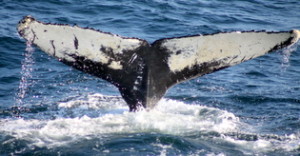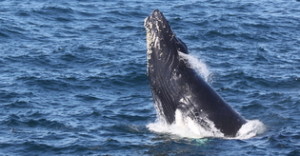Dolphin Fleet Naturalist Notebook – 10 July to 16 July
July 10th was bright and sunny — a welcome change from the previous days of rain. Less than an hour into the trip, we spotted a small group of Atlantic white-sided dolphins, some of which were porpoising, or propelling themselves partially out of the water. Dolphins and other cetaceans will sometimes do this when they are chasing a school of fish. Soon afterward, we found ourselves with 3 humpback whales: Firefly and her calf, as well as a whale named Bandit. Bandit is one of our favorite humpbacks due to his unique feeding style. Many humpbacks will use their tails to generate walls of bubbles which stun and confuse fish, but Bandit is especially energetic, and will wildly thrash his huge tail before lunging through the school.
More excitement occurred on the Dolphin VIII as a couple got engaged on the bow of the boat, just as the whales were surfacing and fluking. This couple will certainly have a unique story to tell at their wedding!
July 11th started out gray and foggy. Humpback whales could be seen intermittently, but in their long absences between surfacings, we suspected that they were deep feeding. By mid-afternoon, the skies had cleared, and we were able to relocate the group of humpbacks that has been dominating Southeastern Stellwagen Bank humpback sightings for the past two months. Alphorn, Pele, Milkweed, Percussion and Cajun appeared every 8-10 minutes to take a few breaths before embarking on another long, deep, dive, while Cajun’s playful calf breached and rolled at the surface. Soon, this calf will be learning how to feed on solid food, rather than its mother’s nutritious milk. For now, this little calf’s almost constant presence at the surface suggests that it is not quite ready for those deep foraging dives!
Cajun’s calf isn’t the only acrobatic calf in our midst. On July 12th our first stop was on a humpback named Rune and her calf. Rune is 30 years old and this is her 11th calf to date. Rune’s calf surprised all of the passengers on the mid-day Portuguese Princess II trip by leaping right out of the water in what we call a full spinning head breach!
In the morning, Cajun and her calf were surrounded by their usual entourage, but by afternoon, they appeared to have gone off on their own, and in their stead, another humpback named Draco had joined the pack. Draco is named for the dragon-shaped marking on the underside of its fluke. Draco is twelve years old and of an undetermined gender. There a few a ways that we can figure out if a whale is male or female: through genetic sampling, by observing or photographing the underside of its body, or by observing a female with a calf by her side. In the absence of such data, we cannot know the sex of an animal.

The morning trip aboard the Dolphin VII on July 13th was notable in that we saw 3 different species of baleen whale. By far, the humpbacks are the most prevalent sightings during our summertimes trips, but we also frequently see the Minke whale, and occasionally the fin whale. Today we saw all of them! The fin whale is the second largest animal on the planet, its length exceeded only by the blue whale. Although fin whales can be seen off of Cape Cod any month out of the year, there is still quite a bit that we don’t know about them. In an effort to gather comprehensive data on fin whales, efforts have been made to study the population by documenting individual animals. This has worked very well for humpbacks as the markings on the underside of their tails are a dead giveaway as to their identity.
In the case of fin whales, individual IDs are not so easy. For one, they rarely fluke, and even if they did, their flukes are not as strikingly distinct as the humpbacks. Instead, we must rely on subtle pigmentation patterns on their right side, as well as the size and shape of their dorsal fin. Because of their great speed and elusive nature, progress has been slow, but today we were able to identify a fin whale named Scorpion.
Later, aboard the Portuguese Princess II, we got an excellent look at Perseid and her calf. Perseid is a female humpback who was going on long, deep dives while her calf rested at the surface. Perseid’s calf is relatively independent and doesn’t stick to his or her mothers’ side like other humpback whale calves. Instead Perseid’s calf slowly approached the boat and floated off our port side. We have been concerned about Perseid’s calf because it seems to have sustained some injuries during the first few months of its life. Propeller scars line its back and its skin is gray and discolored, indicating poor health. We are hoping that it will recover enough that it is ready to go off on its own by the end of the year.

Draco the humpback was seen again on July 14th, and was seen joining and splitting from several different humpbacks throughout the day. While humpback whales will form small groups, these groups lack the cohesion and stability of the tight-knit pods favored by many of our toothed whale species. It is much more likely for humpback whale groups to merge and diffuse throughout the day, without any discernible logic. Certainly, the whales must have their reasons; however, those reasons are beyond what we can deduce with the scientific data at hand. One thing that we have noticed, however, is that the mysterious flipper slapping behavior does tend to precede a change in group dynamics. Today was a day when flipper slapping could be seen throughout the afternoon. Perhaps this had something to do with the rapid changes we were observing!
On July 15th the Dolphin VIII headed out to eastern Stellwagen Bank to find Pele, a male humpback born in 1997. For the past few weeks, Pele has been almost constantly in the company of Milkweed, Cajun and her calf. This morning, however, Pele was all by himself. And he was breaching! We don’t know why humpback whales breach here in the feeding ground (in the mating grounds the breaching is thought to be a territorial display). It would make sense that it would serve a communication purpose, however, and because sound travels well through water, the sound of a 40 ton animal landing on the water could send a message to many other humpbacks in the area.

By July 16th, Pele had calmed down and had rejoined Cajun and the calf, who were seen not far from the eastern edge of Stellwagen Bank. In addition to the humpbacks, we had fin whales and Minke whales. All of these species can be seen off the coast of Cape Cod throughout the summer and into the fall. These three species are all baleen whales, meaning that they use the bristle-fringed keratin plates in their mouth to strain fish from the water. They are also all rorqual whales, meaning that their ventral sides are lined with flexible pleats which expand when the whale gulps down a mouthful of food.
After getting great looks at all of these species, we wrapped up the trip with a surprise tail breach from Draco, a large male humpback. Tail breaches, like many of the behaviors in the humpback whale repertoire, are a behavior that we don’t have a very good explanation for, but it is is likely a form of communication.








